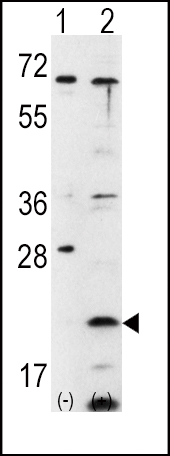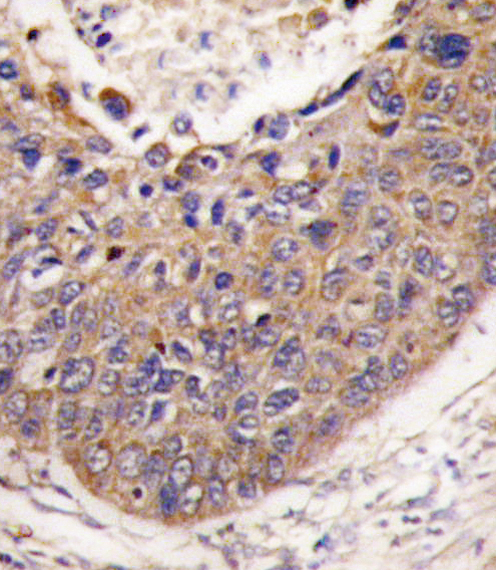


| WB | 咨询技术 | Human,Mouse,Rat |
| IF | 咨询技术 | Human,Mouse,Rat |
| IHC | 1/100-1/500 | Human,Mouse,Rat |
| ICC | 技术咨询 | Human,Mouse,Rat |
| FCM | 咨询技术 | Human,Mouse,Rat |
| Elisa | 咨询技术 | Human,Mouse,Rat |
| Aliases | Frataxin, mitochondrial, Friedreich ataxia protein, Fxn, Frataxin intermediate form, i-FXN, Frataxin(56-210), m56-FXN, Frataxin(78-210), d-FXN, m78-FXN, Frataxin mature form, Frataxin(81-210), m81-FXN, FXN, FRDA, X25 |
| Entrez GeneID | 2395 |
| WB Predicted band size | 23.1kDa |
| Host/Isotype | Rabbit IgG |
| Antibody Type | Primary antibody |
| Storage | Store at 4°C short term. Aliquot and store at -20°C long term. Avoid freeze/thaw cycles. |
| Species Reactivity | Human |
| Immunogen | This FXN antibody is generated from rabbits immunized with a KLH conjugated synthetic peptide between 143-172 amino acids from the C-terminal region of human FXN. |
| Formulation | Purified antibody in PBS with 0.05% sodium azide. |
+ +
以下是关于FXN抗体的3篇代表性文献摘要:
---
1. **标题**:*Friedreich's ataxia: autosomal recessive disease caused by an intronic GAA triplet repeat expansion*
**作者**:Campuzano V, et al.
**摘要**:该研究首次克隆了FXN基因,发现其在弗里德赖希共济失调(FRDA)患者中存在GAA重复扩展突变,并利用特异性抗体证实患者细胞中frataxin蛋白水平显著降低,为疾病机制研究奠定基础。
2. **标题**:*The neuropathology of Friedreich’s ataxia*
**作者**:Koeppen AH, et al.
**摘要**:通过免疫组化及Western blot分析,研究揭示了FRDA患者神经组织中frataxin蛋白的缺失模式,FXN抗体被用于定位frataxin在线粒体中的表达,关联了蛋白缺失与神经元退行性病变的关系。
3. **标题**:*Frataxin gene editing rescues frataxin deficiency in Friedreich’s ataxia patient-derived neurons*
**作者**:Li Y, et al.
**摘要**:研究利用CRISPR/Cas9技术修复FRDA患者神经元中的FXN基因突变,通过FXN抗体检测到frataxin蛋白表达恢复,证实基因治疗对该疾病的潜在疗效。
---
这些文献涵盖了FXN抗体在基因功能研究、病理机制探索及治疗评估中的关键应用。如需具体期刊或年份等细节,建议通过PubMed或学术数据库进一步查询。
FXN antibodies are immunological tools designed to target frataxin, a highly conserved mitochondrial protein encoded by the *FXN* gene. Frataxin plays a critical role in iron-sulfur (Fe-S) cluster biogenesis and mitochondrial iron homeostasis. Reduced frataxin levels are directly linked to Friedreich's ataxia (FRDA), a recessive neurodegenerative disorder characterized by progressive motor impairment, cardiomyopathy, and diabetes. FXN antibodies are widely used in research to detect frataxin expression in cells and tissues, aiding in the study of FRDA pathogenesis, iron metabolism dysregulation, and mitochondrial dysfunction.
These antibodies are essential for techniques like Western blotting, immunohistochemistry, and ELISA to quantify frataxin levels in experimental models (e.g., patient-derived cells, animal models) or assess the efficacy of therapeutic strategies, such as gene therapy or protein replacement. Commercial FXN antibodies are typically raised against specific epitopes (e.g., human frataxin residues 55–70 or 135–150) and vary in host species (rabbit, mouse) and clonality (monoclonal/polyoclonal). Validation includes knockout controls, recombinant protein reactivity, and cross-species recognition (human, mouse, rat).
Challenges include ensuring specificity due to frataxin's low abundance and potential cross-reactivity with homologous proteins. Recent advances in antibody engineering have improved sensitivity and reproducibility, supporting FRDA biomarker studies and drug development. Overall, FXN antibodies remain pivotal in elucidating frataxin's biology and advancing translational research for FRDA and related mitochondrial disorders.
×